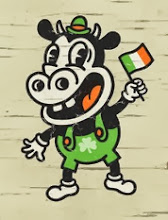The Lianhan Shee
The Lianhan Shee is a formidable fairy. She is the femme fetale of the fairies, using her power to gain dominion over mortal men. It is thought that if a mortal man can refuse her, she will become his slave...but if he succumbs to her magical desire, he is hers for eternity. Because of her irresistible attractiveness, most men cannot turn her away, and then they live only for her pleasure, sacrificing all else, until this frenzy destroys them. The Lianhan Shee lures men to follow her into the world of fairies, and the men follow even though they will die to reach that realm.
Also, today is a special day because it is Beltane Day. Beltane or Beltain (pron.: /ˈbɛlteɪn/) (also Beltine or Beltaine)[1] is the Gaelic May Day festival. Most commonly it is held on 30 April–1 May, or halfway between the spring equinox and the summer solstice. In Irish it is Bealtaine ([ˈbʲal̪ˠt̪ˠənʲə]. . It is one of the four Gaelic seasonal festivals; along with Samhain, Imbolc and Lughnasadh.
Beltane is mentioned in some of the earliest Irish literature and it is associated with important events in Irish mythology. It marked the beginning of summer and was when cattle were driven out to the summer pastures. Rituals were performed to protect the cattle, crops and people, and to encourage growth. Special bonfires were kindled, and their flames, smoke and ashes were deemed to have protective powers. The people and their cattle would walk around the bonfire, or between two bonfires, and sometimes leap over flames or embers. All household fires would be doused and then re-lit from the Beltane bonfire. Doors, windows, byres and the cattle themselves would be decorated with yellow May flowers, perhaps because they evoked fire. In parts of Ireland, people would make a May Bush; a thorn bush decorated with flowers, ribbons and bright shells. Holy wells were also visited, while Beltane dew was thought to bring beauty and maintain youthfulness. Many of these customs were part of May Day or Midsummer festivals in other parts of Great Britain and Europe.




No comments:
Post a Comment